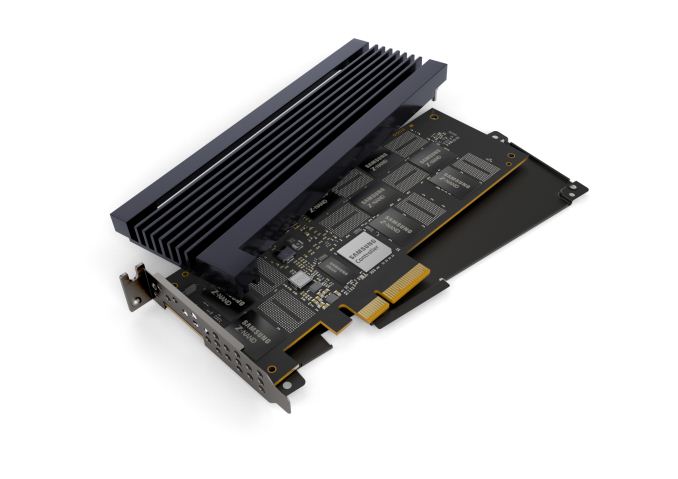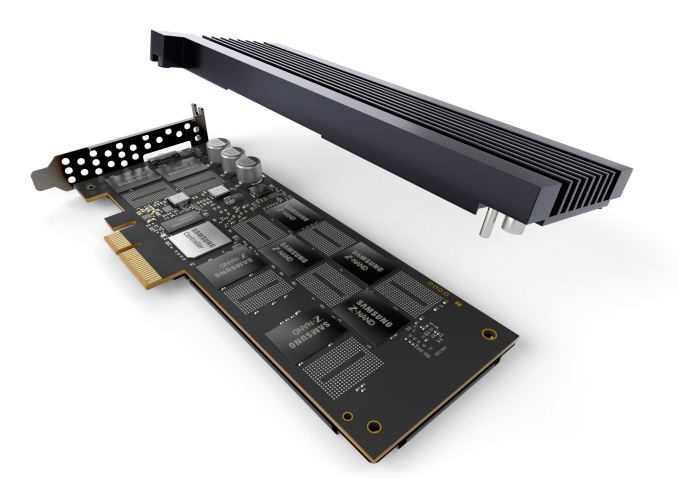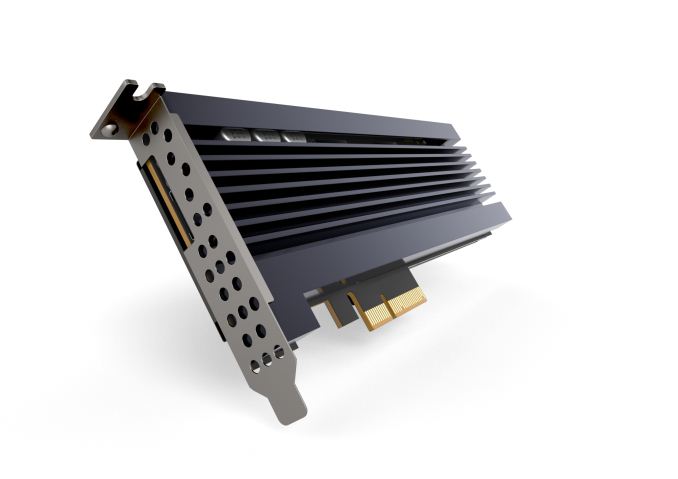Samsung Launches Z-SSD SZ985: Up To 800GB Of Z-NAND
by Billy Tallis on January 29, 2018 9:00 PM EST
Samsung announced today that they are officially launching their first Z-SSD product, the SZ985. The Z-SSD uses Samsung's Z-NAND memory, a high-performance derivative of their 3D NAND flash memory and Samsung's intended competition for Intel's 3D XPoint memory. The SZ985 is a high-performance, high-endurance enterprise NVMe SSD.
Samsung has been talking about Z-NAND and the SZ985 for quite a while, including showing off prototypes at several trade shows and conferences. Their initial announcement in 2016 of Z-NAND memory and Z-SSD drives promised 1TB drives in 2016 to be followed by 2TB and 4TB drives in 2017. Today's launch of 800GB and 240GB models is far behind that initial timeline, but the Z-SSD is finally ready for broad release, almost a year after Intel's Optane products first hit the shelves. Samsung hasn't provided much new information about how the Z-SSD works under the hood, but they have disclosed that the drive includes 1.5GB of LPDDR4 DRAM. This suggests that the Z-SSD either has huge overprovisioning with as much as 1.5TB or Z-NAND memory for the 800GB model, or that the Z-NAND is being managed in a way that requires more than the usual 1GB of DRAM per TB of NAND flash used by most SSDs.
Samsung has not provided full performance specifications for the SZ985, but they have highlighted several key metrics that put the Z-SSD in the top performance tier. The SZ985 can deliver up to 750k random read IOPS, well above the 550k IOPS that Intel's Optane SSD DC P4800X is rated for. Write performance from the SZ985 is much less impressive at only 170k random write IOPS. The random write speed rating on Intel's P4800X is only 9% slower than the random read speed, while the Samsung SZ985 will have a random write speed that is 77% slower than random reads. Samsung has not been able to overcome all of the limitations of flash memory, but they have produced some impressive improvements.
Samsung also makes a few comparisons against more mainstream enterprise SSDs based on 3D TLC NAND flash memory. The memory cell read performance of their Z-NAND is ten times higher than their 3D TLC NAND, leading to 70% higher random read throughput than their PM963 NVMe SSD. Exact read latency isn't specified, but write latency on the SZ985 is quoted as 16 µs.
Despite not having record-setting write performance, the SZ985 is still designed to handle very write-intensive workloads. The endurance rating is 30 drive writes per day for five years, matching Intel's Optane SSD. However, both drives still fall short of the long-gone Micron P320h SLC NAND SSD, in both performance and endurance (though Intel has at least exceeded the random write speed of the P320h). Samsung's most significant accomplishment with the Z-SSS SZ985 is likely that they can offer the performance of planar SLC at much lower cost thanks to their 3D NAND structure.
Samsung will be presenting the Z-SSD SZ985 at the International Solid-State Circuits Conference, February 11-15.
At Flash Memory Summit last year, Samsung announced a second generation of Z-NAND memory. The SZ985 is still a first-generation product, and drives with the second-generation Z-NAND could still be a long way from launching.
Source: Samsung












45 Comments
View All Comments
GhostOfAnand - Monday, January 29, 2018 - link
I want z nand! Where is z nand?woggs - Monday, January 29, 2018 - link
So this is SLC 3D nand with bigger DRAM cache and very fast indirection system (possibly HW automated)? Obviously have to really squint hard, reading between the lines.aryonoco - Tuesday, January 30, 2018 - link
I think the article implies that this is NOT SLC.IntelUser2000 - Tuesday, January 30, 2018 - link
Yes, it is actually. Based on Anandtech's own article: https://www.anandtech.com/show/11703/samsung-at-fl...2nd generation moves to MLC to lower cost.
Looking at the specs, this is actually close to Intel's SSD DC P3700 SSD.
CheapSushi - Tuesday, January 30, 2018 - link
The whole point of Z-NAND is to get SLC performance for cheaper by using MLC & TLC NAND in SLC mode.iter - Tuesday, January 30, 2018 - link
You can use tlc flash in slc mode about as much as you can use a moped in harley davidson mode.XabanakFanatik - Tuesday, January 30, 2018 - link
That's exactly how SLC cache is done, they use sone of the TLC as SLC. Educate yourself.iter - Tuesday, January 30, 2018 - link
Slc cache is slc memory. Different chip than the main tlc memory. Which is why those drives can only continuously write at a high speed until that cache is filled, and afterwards the drive performs at a much lower performance level, because it is using the much slower main flash memory. Adoy!Lolimaster - Tuesday, January 30, 2018 - link
The is no SLC memory in any SSD that is not an actual SLC SSD. They simply simulate it the same way your HDD pagefile "simulates" ram.karatekid430 - Tuesday, May 22, 2018 - link
Multi-level cell is just dividing the flash up into more than two levels. SLC is read as 0 or 1. MLC has 0, 1, 2, 3 (2-bit) and TLC 0, 1, 2, 3, 4, 5, 6, 7 (3-bit). Although each might be optimised and manufactured slightly differently, most of the characteristics arise from how the flash is used by the controller. TLC does not wear faster - but because it needs to be more precise than SLC, it is less tolerant to wear before it becomes too unreliable, and the controller retires the cell. So if you write to TLC with only two levels (0, 1) like SLC, you should get similar characteristics to SLC, including the controller needing less time to read or write to it, because there is more margin for error. Think of it as either completely filling or emptying a bucket of water (fast) rather than having to precisely top it up or remove water to a certain partial capacity (slow and needs precision). Normally I would agree that TLC is not SLC, but in this case, it is more about how it is used, and not the capacity.You might not be able to use SLC flash with a TLC controller - it might not be designed to be partially filled or emptied to that precision. But using TLC as SLC? I would believe that.